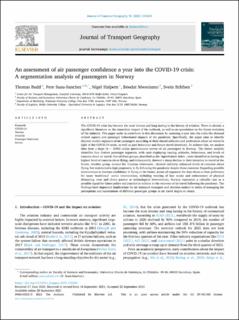| dc.description.abstract | The COVID-19 crisis has become the most intense and long-lasting in the history of aviation. There is already a significant literature on the immediate impact of the outbreak, as well as on speculation on the future evolution of the industry. This paper seeks to contribute to this discussion by assessing a year into the crisis the demand related aspects and passenger behavioural impacts of the pandemic. Specifically, the paper aims to identify discrete market segments of air passengers according to their shared attitudes and preferences about air travel in light of the COVID-19 crisis, as well as past behaviour and future travel intentions. To achieve this, we analyse data from a large (n = 2096) online questionnaire survey of air passengers in Norway. The cluster analysis identifies four distinct passenger segments, with each displaying varying attitudes, behaviours, and levels of concern about air travel. One of these groups, described as the ‘Apprehensive Elders’, were identified as having the highest level of concern about flying, and subsequently showed a sharp decline in their intention to travel in the future. Another group, termed the ‘Cautious Commuters’, showed similarly enhanced levels of concerns about flying, but maintained a high propensity to fly following the pandemic despite these concerns. Regarding possible interventions to increase confidence in flying in the future, across all segments the data shows a clear preference for more ‘traditional’ active interventions, including wearing of face masks and enforcement of physical distancing, over and above passive or technological interventions. Norway represents a valuable case as a possible signal for future policy and practice in relation to the recovery of air travel following the pandemic. The findings have important implications for air transport managers and decision makers in terms of managing the perceptions and expectations of different passenger groups as air travel begins to return. Keywords: COVID-19, Norway, aviation, passenger behaviour, survey | en_US |

